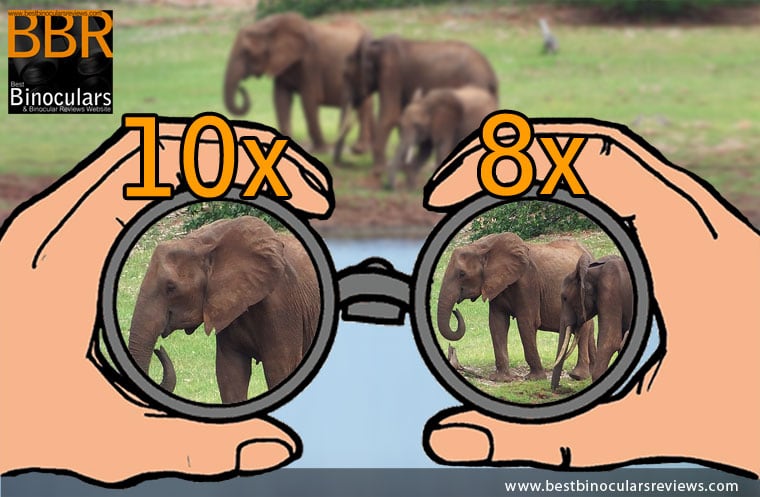I asked this question in a hurry. We were at the airport waiting to fly to Peru, our once in a lifetime trip was planned to the last detail. I had forgotten to sort out binoculars for our stay on an oxbow lake in the Amazon. With so much variety I had to understand what do binocular numbers mean?
In this article I am going to explain about the two numbers often found printed on the body of a binocular. The binoculars in front of me are 8x40. Searching for the extremes I found 6x21 and 25x150. Why are these numbers important?
Binocular magnification
Of the two numbers “8x40”, the first number is its magnification. Binocular magnification is sometimes referred to as power, I will just use the term magnification. You will notice the “x” alongside the “8” in my example, this belongs with the number. Meaning “8x” or eight times magnification.
The purpose of binoculars is to allow you to see a distance object more clearly by making them look larger, as if you were seeing them from much closer. My “8x” binocular makes the object I am looking at appear eight times larger than it would if I look at it with just my eyes (unaided).
Binoculars with 8x40, 8x42, 8x70, 8x32, or even 8x21 all offer the same magnification. They will all magnify the image by eight times. Likewise 10x42 will magnify ten times, 12x50 will magnify twelve times.
How about 30-160x70? This example is taken from the Sunagor 30-160x70 BCF Mega Zoom Binoculars. It has a range of magnification (sometimes referred to as zoom binoculars) 30-160x, and thus the power can be adjusted anywhere between 30 times and 160 times.
Such high magnification will not suit all intended uses, and more about the competing factors for choosing magnification are in this guide to How a Binoculars Magnification affects Stability, Field of View & Image Brightness.
Objective lens size
Of the two numbers “8x40”, the second is the diameter of the main objective lenses, in millimeters.
Using the same examples, an 8x40 binocular has 40mm diameter objective lenses. Whereas 8x21 has 21mm objective lenses, although with the same magnification.
Comparing 6x21, 8x21, 8x42, and 10x42. These have objective lenses with diameters of 21mm, 21mm, 42mm, 42mm.
The surface area of the objective lens captures light from the scene, and transmits it to the ocular lens (which then transmits that light to your eye). A larger objective lens captures more light and so the image seen is brighter. In low light conditions the more light that can be transmitted to the eye the better.
A 42mm objective lens has four times the surface area of a 21mm lens, and so has the ability to captures four times more light (area = pi x radius squared).
25x150 binoculars capture over twelve times more light than 10x42.
Do these numbers tell the whole story?
So we have established that the binocular numbers provide the magnification and the size of the objective lenses on a bino. The surface area of the objective lenses can be calculated, which determines how much light is captured by those particular objective lenses.
The two measures, magnification and size of objective lenses, relate to the field of view. Field of view is how wide an area is encompassed in the image seen through the binocular.
As the size of the objective lens increases, so does the field of view. As the magnification on a binocular increases the field of view decreases. So almost every 8x42 has a wider field of view than a 10x42. Just remember, other factors also affect the field of view, so two 10x42 from different manufacturers may have a different field of view.
Also: The numbers do not indicate how much of the light captured is actually transmitted to the eye, as the quality of the materials used in the lenses and other components on the light path determines how much light is lost (not transmitted).
They also do not indicate the weight of binoculars, as more powerful magnification and larger objective lenses will increase the overall weight. This may determine whether the binoculars can be used handheld or using a tripod (or with a monopod).
There are many other factors that influence the suitability of binoculars for a particular intended use. How big is the eye relief? How large is the subject being observed? How far away will you be from the subject? What is the minimum focus distance?
Summary
What do the numbers on binoculars mean? I hope you have found this article informative. The first number (including the X) is the power (magnification). The second number (immediately following the X) is the size of the objective lenses.
Together these numbers inform you how much larger an object will appear through the binoculars, and how bright the image seen will appear relative to the amount of light available.
The binocular numbers do not answer all the questions you may have about a particular pair of binoculars.
Further Reading
- Next: If you are interested in buying your first binoculars, take a look at our guide: What To Look For When Buying Binoculars
Please contact me if you have any further questions.
The post What do binocular numbers mean? appeared first on Best Binocular Reviews.



